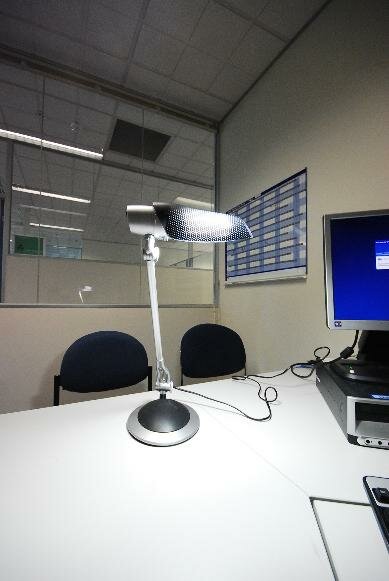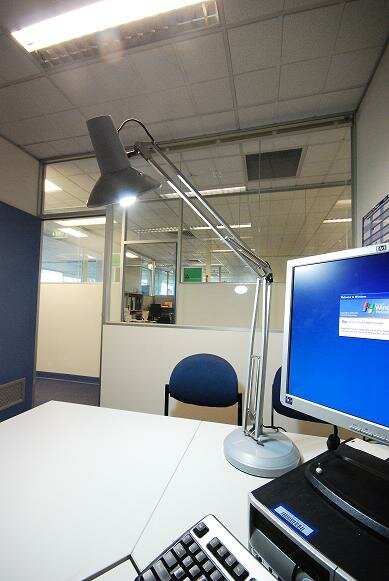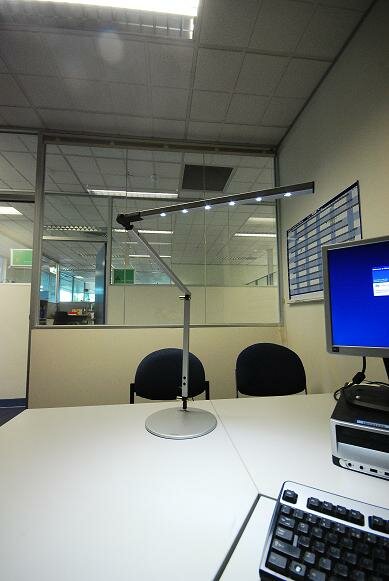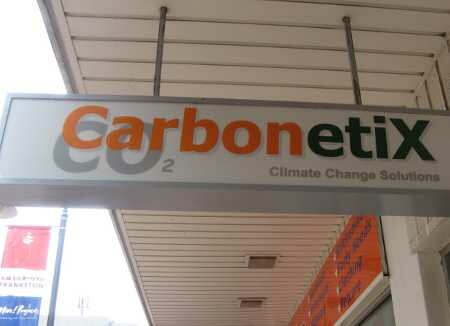T5 fluorescent lighting has been around for a while now, but is not yet widely used in the manufacturing or warehouse sectors. Paul Smith has compared T5s with metal halide, and is interested in how T5s compare in terms of their total environmental impact.
As Paul writes, T5s strike faster, have good colour rendition, and a well designed T5 high bay luminaire, with 4 tubes, can be more efficient than a metal halide lamp, and have less lumen depreciation over its lifetime.
Both metal halide and T5 lamps contain mercury. T5 refers to the diameter of the tube, with T5 tubes being 5/8″ (16mm) in diamater. “Standard” fluorescent tubes are called T8s and are 8/8″ (25mm) in diameter. With a smaller diameter T5s use less glass and mercury than a T8 of comparable brightness.
Having said that, quite a few myths have developed around T5 lamps and as a result many people believe they are the best thing since sliced bread was invented. The luminous efficacy in lumens per watt of good T5 lamps approaches 105 lumens per watt, but this is only slightly better than the best T8 which is near 100 lumens per watt. Large wattage metal halides also have luminious efficiencies approaching 100 lumens per watt. However, like most things, just because a lamp is a T5 doesn’t mean its luminous efficacy is above 100 lumens per watt, there are many T5s on the market with an efficacy of only 80 lumens per watt.
The uptake of T5s has been much greater in the commercial building sector, particularly in offices, than in manufacturing and warehouses. The reason for this I believe is LEED (in Australia Greenstar) and other standards where building designers are seeking maximum efficiency in lighting. These drivers aren’t yet as strong in the manufacturing and warehouse sectors. Certainly in our work we mostly come across T5s in office buildings which are pursuing a high green star rating. And metal halide highbay light fittings are still much cheaper and much more readily available than T5 highbay fittings.
If you are designing a new commercial building it makes economic and environmental sense to use T5 lighting with high efficiency luminaires. The luminaire (light fitting) chosen is important too. The purpose of the luminaire is to direct the light coming out of the tube to where it is needed. Low efficiency luminaires are inefficient at doing this. To get the most out of T5 lighting you also need to be specifying high efficiency luminaires. A big advantage T5 lights have over conventional T8 is their use of an electronic ballast, which extends lamp life, eliminates flicker, and reduces lumen depreciation.
For a commercial building retrofit the use of high efficiency replacement T8 tube in a double fluorescent luminaire and fitting of a specular reflector behind the tube to increase the efficiency of the luminaire enables the removal of one tube and halves energy use of the fitting. This is called delamping (more at our delamping webite). This provides larger energy and cost savings and is less expensive and more reliable than fitting T5 adaptors - devices than enable a T5 tube to be used in a T8 fitting. T5 tubes fitted with T8 adaptors have a lower luminous efficacy than the best T8 tube, so their use is not advised, not withstanding the marketing hype surrounding T5 adaptors.
In new warehouses in my opinion T5 high bay luminaires as described by Paul are far superior to metal halides. Paul outlines several reasons for this. The instant start of T5s is in many case perhaps the biggest advantage. When undertaking energy audits of warehouses I have usually see the high bay lights running all day, even though different sections of the warehouse will often be empty. This is very wasteful. Unfortunately HID lamps, such as metal halide, high pressure sodium, and the less efficient but inexpensive mercury vapour all take a long time to warm up, and therefore its not practical to switch them off in empty spaces. Forklift operators and staff just aren’t prepared to wait 10 or 15 minutes for the lights to warm up to full brightness.
T5 or T8 linear fluorescent lamps don’t have this problem. So they can be controlled by motion or occupancy sensors. In many cases the hours of operation of lights in warehouses could be reduced from 10 to 12 hours a day to less than 4 hours a day with the use of sensors and T5 high bay fittings. Lighting energy costs can easily be halved.
Another metal halide replacement is the induction lamp, which has the advantage of instant start as well, but can in some cases be retrofitted into the existing high bay fittings. Their luminous efficacy is also pretty good, they are easily dimmed (good where daylighting controls are installed), and prices are coming down. Induction lamps also have a very long lamp life, in the order of 50,000 hours (compared with 14,000 hours for a good metal halide and 20,000 hours for a good T5)
LED lighting is rapidly becoming more efficient, and we have tested LED fluorescent tube replacements achieving over 70 lumens per watt - which is a big improvement over the 40 to 50 lumens/watt we were seeing 12 to 18 months ago. If the luminous efficacy of white LED technology continues to improve this quickly, and prices start to drop, then we may find in five years time that LED is better than all other forms of lighting.



















